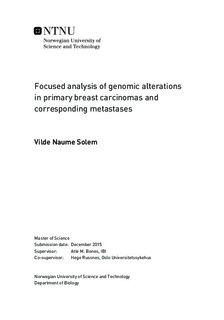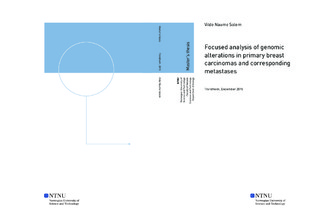| dc.description.abstract | Breast cancer is one of the leading causes of cancer mortality worldwide. Distant metastases are nearly always the direct cause of death, and understanding its relationship to the primary tumor is of great importance. Today, the choice of treatment is, in most cases, based upon histological and molecular analysis of the primary tumor. However, recent studies suggest that the cancer cells may spread to distant organs earlier in tumor progression than previously believed and that genetic alterations can evolve independently in the primary tumor and metastasis. Some studies report of a close resemblance between primary tumors and their corresponding metastasis, while others report of genetic divergence. The conflicting results reflect the need for a deeper understanding of the molecular mechanisms underlying metastatic disease, to be able to improve treatment strategies and clinical outcome.
The objective of this thesis was to investigate whether the somatic mutations found in a lymph node metastasis differ from those in the corresponding primary breast tumor. Targeted sequencing of 20 primary breast tumors and their matched lymph node metastases was performed by the use of Ion Torrent Personal Genome Machine. The Ion AmpliSeq Cancer Hotspot Panel v2 was utilized, targeting 207 regions in 50 genes found to be frequently mutated in cancer. The genetic variants were compared to public databases such as dbSNP, 1000 genomes and COSMIC. 55% of the tumors were found to harbor at least one somatic mutation (median 0,8, range 0-3). Frequently mutated genes included TP53 (45%) and PIK3CA (25%). The vast majority of the metastases seemed to retain the somatic mutations detected in the primary tumor, but the variant frequencies were slightly different. In three of the patients a TP53 mutation unique to the primary tumor and/or the lymph node metastasis were revealed. The differences indicate that dissemination may occur at different time points during disease progression, and that analysis of metastatic tumors could provide additional insight affecting treatment decisions. However, as only a small piece of each tumor was analyzed and only selected regions of the cancer genomes were sequenced, no conclusion can be drawn about the time of dissemination or the level of heterogeneity of the tumors. Further analysis of the samples, including copy number analysis and whole genome sequencing, should lead to a broader understanding of breast cancer progression from a local to a metastatic disease. | |

